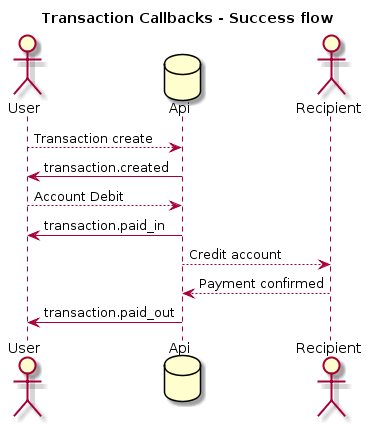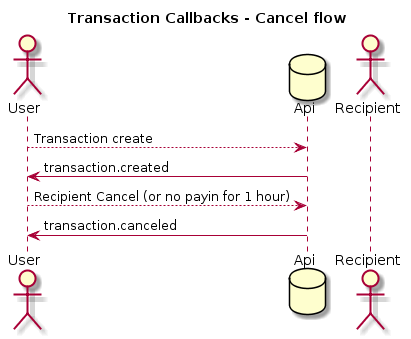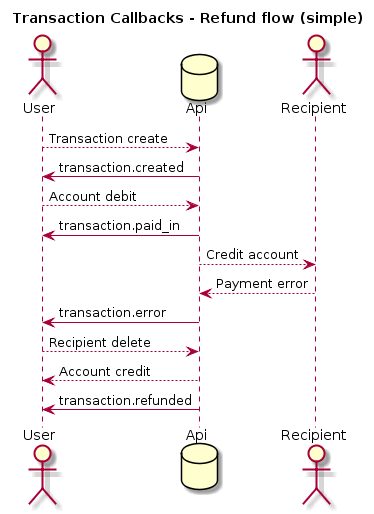Architecture
- Authentication
- Status codes
- Webhooks
- Metadata
- External ID
- Senders
- Recipients
- Transactions
- Balances
- API Limits
Authentication
Every API call needs to be authenticated. See the authentication documentation for more details on the authentication process.
Status codes
Generally in our API there are two types of status codes used:
- A
200or201status code means that the request was accepted, and there were no issues with it. - A
422status code is used whenever there was a validation error with the request. In case of validation errors, they are returned in theerrorsfield, other errors are usually present in themetafield in the response.
Webhooks
A webhook is a callback which enables our API to notify your system of new events concerning your transactions. Whenever objects in the AZA Finance API change state, we can optionally send the changed details to a pre-registered webhook address. Webhooks can be created either using the developer portal, or using the AZA Finance API.
Whenever possible we prefer using webhooks to listen on events (for example when a transaction has been paid out) instead of polling the status, and we expect implementations fully utilising webhooks.
Webhooks will always generate a POST request to the specified endpoint, and will also include the same authentication headers as described in the authentication documentation, so their validity can be verified on the receiver end.
Please ensure that you have whitelisted the following IP addresses. The following is for each of our environments:
52.50.88.9- Production52.30.76.100- Sandbox
In case of a transmission error we will also try to send the webhook again five times before dropping the request. You’ll need to reply to the endpoint call with a successful status code (e.g. 200 or 201), otherwise we’ll assume that the webhook was not delivered.
Warning! Make sure your endpoints are reachable from the IPs mentioned above and are not timing out. Callback endpoints that don’t return a HTTP response in time (even a failing one), but time out will be disabled automatically by our system after a number of retries to protect our other customers. Automatically disabled webhooks need to be recreated manually by the customer.
The structure of the body we send will always follow the following template:
There are examples showing how to parse a received webhook message using our SDKs:
- Java 7 webhook example
- Java 8 webhook example
- Ruby webhook example
- Javascript webhook example
- PHP webhook example
- .NET webhook examples:
The following are examples of some possible webhook flows and events. Please note this is not an exhaustive list however covers the majority of cases:
Transaction success

Transaction canceled

Transaction refunded

You can obtain an up-to-date list of available webhook events using the Webhook Events endpoint of our API.
Metadata
Most models in the AZA Finance API allow storing any metadata, which will be returned when querying the object, including callouts from webhooks. This facility can be used to store any data on the models.
External ID
An external ID can be included when Transactions are created, which are typically used for linking transactions to the models inside the API user’s system. If the specified external ID already exists in our system the transaction will fail to validate, and the corresponding duplicate transaction will be returned along with an error.
For more information on External IDs, see the Transaction flow documentation
Senders
The senders model stores information about who sends the money for the transaction. Only senders that are KYC’d are allowed to pay in money.
If your site already does KYC on the senders, then let us know as we might waive the requirement to send us sender documents to ease the usage of our API. Otherwise you will have to send us documents for each sender which we will validate. Please also check our KYC documentation for more info.
As with transactions, external IDs can also be included for senders when a transaction is created. If this ID already exists in our system, any details sent along with the external ID are used to update the sender.
You can read more on creating senders in the Transaction flow documentation.
Recipients
The recipient model stores information about who receives money from a transaction, and whether the money has already been paid out or not. Any issues during the payout process are also stored against the recipient, therefore when checking for transaction issues one has to also subscribe for events on the recipients.
You can read more on recipients and how they work during transactions in the Transaction flow documentation.
Transactions
The main model of the AZA Finance API is the Transaction, which store the flow for sending money from one Sender in a specific currency, to one or multiple Recipients in another currency. You can read more on transactions in the Transaction flow documentation.
Balances
If you have a balance with us you can use the GET /v1/accounts to get all or GET /v1/accounts/[CURRENCY_NAME] endpoint to obtain a specific currency’s balance with us.
Please contact us to obtain our list of supported currency pairs for transactions.
API Limits
We have soft limits around some of the endpoints that we ask customers to adhere to. These are the following:
| Endpoint | Call limit / day | Notes |
|---|---|---|
GET /v1/transactions/[ID] |
2500 | Please use the webhook/callback functionality to obtain the status of transactions. You can also find this information on your daily account report every day. Please also make sure to avoid calling the status check endpoint more often than six times in the first hour of transactions creation, and then subsequently only once every hour for each separate transaction ID you have active in our system. |
GET /v1/accounts* |
300 | Please keep track of your account balance internally in your system if you need this information more often |
GET /v1/info/currencies* |
300 | See get current exchange rates on alternative options you can do if you need to obtain currency information more often |